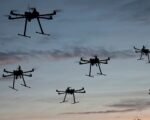In an industry where innovation is the key to advancement, Embraer has taken a significant leap by selecting Dassault Systèmes’ simulation technology. This strategic move is set to revolutionize the development of quieter electric vertical take-off and landing (eVTOL) aircraft for Eve Air Mobility, marking a new era in urban air travel.
Embraer’s choice of Dassault Systèmes’ SIMULIA PowerFLOW simulation technology is a game-changer for the aerospace sector. This powerful tool enables engineers to simulate, analyze, and test eVTOL aircraft in virtual environments, predicting real-world operating conditions with unprecedented accuracy.

The first paragraph under this subheading highlights the importance of noise reduction in eVTOL design, especially since these aircraft are intended for operation in urban areas. Dassault Systèmes’ technology allows for the optimization of critical design elements, ensuring that the aircraft not only perform well but also contribute to a quieter cityscape.
The second paragraph delves into the collaborative efforts between Embraer and global partners to provide sustainable and integrated Urban Air Mobility (UAM) solutions. The focus on human-centric design ensures the safety and comfort of passengers and the community, minimizing noise pollution.
The third paragraph discusses the progress of Eve’s eVTOL, with the first production facility established in São Paulo, Brazil. The assembly of the first full-scale prototype and the test campaign set for 2024 are significant milestones, leading up to the anticipated service launch in 2026.
Advancing Sustainability in Aviation
The second subheading explores the environmental benefits of eVTOL aircraft. Being electrically powered, they offer a more sustainable alternative to traditional combustion-powered aircraft. This aligns with the global shift towards greener technologies and the aviation industry’s commitment to reducing its carbon footprint.
The first paragraph under this subheading emphasizes the role of simulation technology in achieving these sustainability goals. By accurately predicting flight performance and sound emission, Embraer can refine the eVTOL design to be both efficient and eco-friendly.
The second paragraph provides insight into the technical capabilities of the SIMULIA PowerFLOW application. Its robust fluid dynamics simulation tools are industry-proven, allowing for a comprehensive evaluation of the aircraft’s aerodynamics and aeroacoustics.
The third paragraph reflects on the broader implications of Embraer’s decision for the industry. By prioritizing sustainability and noise reduction, the company sets a precedent for future developments in aviation technology.
Charting the Future of Urban Air Travel
The final subheading addresses the long-term vision for eVTOL aircraft and their role in transforming urban transportation. With Embraer’s pioneering efforts and Dassault Systèmes’ advanced simulation technology, the dream of a quieter, more sustainable mode of city travel is closer to becoming a reality.
The first paragraph under this subheading considers the potential impact of eVTOL aircraft on the urban landscape. As cities grow and evolve, the integration of these aircraft into the transportation infrastructure could significantly alleviate ground traffic congestion and reduce urban noise levels.
The second paragraph discusses the challenges and opportunities that lie ahead for Embraer and Eve Air Mobility. While the technological advancements are promising, the success of eVTOL aircraft will depend on regulatory approvals, public acceptance, and continued innovation.
The third paragraph concludes with a forward-looking perspective on the future of air mobility. As Embraer and Dassault Systèmes lead the way, the industry watches with anticipation, ready to embrace the next frontier of urban air travel.








